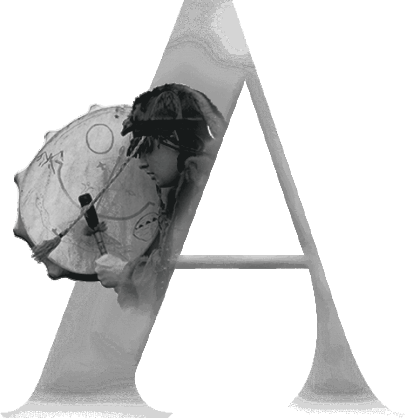The use of plants in shamanic practice
In the taiga regions of Siberia, fly agaric seems to have been the only widely known mushroom used when entering an altered state of consciousness. But in areas with more diverse and rich flora, different plants were used more often. A wide variety of plant substances were used by the peoples of the Far East. In folk medicine and as intoxicating preparations here are compositions of ginseng root, sweet borschtberry, leaves of Ledum, branches of juniper and some others. Compared to the fly agaric, they have a rather weak effect. Most often their use requires careful, often pharmacologically complex preparation or combination of several components. The ways of using the preparations in the peoples of the Far East are more diverse: the plants here were drunk, chewed, often burned and inhaled smoke.

Most often their use is also associated with shamanic practices. Thus Nivkh shamans necessarily practiced before and during the rites burning of Ledum. A special smoke ring for this purpose was an invariable attribute of the shaman, along with a belt, costume and drum.
The shamans of the Udegeans, Ulchi, Nanai and Orochi also used Ledum during rituals. They threw dried leaves prepared in advance into the hearth or on a hot pan. The smoke created in a closed room a favorable environment for a session of communication with spirits, contributing to the onset of mass hypnosis of those present and shamanic trance.
Among the Ainu, branches of spruce, larch, wild garlic and a plant with the local name "nutya" were placed in hot ashes before the ritual. Smoldering, these plants exuded a fragrant smell, the smoke was probably a weak tranquilizer. The shaman drank salty sea water, in which the branches of spruce and nutya were soaked. The juice of the plant helped the shaman to achieve a state of altered consciousness. During the session, the shaman drank this liquid two or three more times.
The inclusion of plant substances in the context of the rite, apparently, is a dominant feature of the culture of their use among the peoples of the Far East. Trance and contact with the spirit world were, apparently, the basis for the nutritional use of these plants. But there was also no developed shamanism in the Far East, but rather its early form.
The shamans of the Udegeans, Ulchi, Nanai and Orochi also used Ledum during rituals. They threw dried leaves prepared in advance into the hearth or on a hot pan. The smoke created in a closed room a favorable environment for a session of communication with spirits, contributing to the onset of mass hypnosis of those present and shamanic trance.
Among the Ainu, branches of spruce, larch, wild garlic and a plant with the local name "nutya" were placed in hot ashes before the ritual. Smoldering, these plants exuded a fragrant smell, the smoke was probably a weak tranquilizer. The shaman drank salty sea water, in which the branches of spruce and nutya were soaked. The juice of the plant helped the shaman to achieve a state of altered consciousness. During the session, the shaman drank this liquid two or three more times.
The inclusion of plant substances in the context of the rite, apparently, is a dominant feature of the culture of their use among the peoples of the Far East. Trance and contact with the spirit world were, apparently, the basis for the nutritional use of these plants. But there was also no developed shamanism in the Far East, but rather its early form.

A certain tendency can be traced in the successive alternation of magical and shamanic in achieving trance: the stronger the effect of the plant, the lesser the role played by the shamanic trance itself; and the weaker the effect of the substance, the greater the importance of the technique of controlled trance. In extreme cases the latter takes on a symbolic significance; the direct effect is practically unused. This becomes quite noticeable if we consider the use of very small quantities of plants in therapeutic and ritual practice.
One of such plants is juniper. It was used and is still used by many peoples in Siberia, and in a rather monotonous way. The pleasant aroma of the burning plant, which has a relaxing and soothing effect on a person, in many peoples of Siberia was considered purifying, destructive to evil spirits. For example, when treating mentally ill Nivkhs, they were fumigated with smoke from juniper branches. The effect of the smoke was understood as sacred (symbolic). Not spirits possessed the plant, but the plant through smoke influenced spirits, driving them away from patients, by its own natural power.
Smudging with juniper smoke is especially widespread in Southern Siberia. In Tuva juniper is an obligatory component of ritual practice. Any healing begins with the ritual of smudging - cleansing from evil. In general, any place where there may be evil forces is necessarily smudged. This is especially characteristic of funeral and memorial rites. Thus, after the funeral the yurt was necessarily fumigated, during the memorial meeting of relatives with the soul of the deceased the shaman necessarily lit a smoker with juniper. In works devoted to the analysis of shamanic props in Tuva, usually much attention is paid to the costume, drum, mirror and images of spirits, the artysh is usually not given importance.
Nevertheless, a lamp with a powder of dried juniper twigs or the dried twigs themselves are one of the most important attributes of Tuvan shamans.
A shamanic session among Tuvans usually begins with smudging artysh. The shaman lights a lamp or sets fire to a twig and cleanses, first of all, himself and his tools. He usually does this in a certain sequence by circling the lamp around the object 3 or 9 times: first a drumstick, then a headdress, which is immediately put on his head, then a drum, and finally cleans himself by swiping his feet over the smoldering artysh – 3 times with his left foot, then also with his right and again with his left 2 times.
The client is also cleansed before the ceremony by making circles around the face and hands folded in front of him. If a large ceremony is held, all those present are cleansed in a similar way with sacred smoke. At the same time, during the ceremony, the juniper must constantly smolder so that it does not go out, either the shaman himself or an assistant chosen from among those present watches.
The Artysh should burn constantly only indoors, outdoors it is not necessary. Apparently, juniper smoke used to be more actively used for contact with the spirit world. If you stay in such a room for a long time, and shamanic rituals usually last several hours, the effect of this smoke can be very strong. Now shamans use juniper without thinking about its qualities, for them it has turned into a symbolic natural force, not personified in specific images. In the view of Tuvan shamans, artysh helps contact with spirits, as well as such abstract non-personalized concepts as mind, light, sound, purity.
One of such plants is juniper. It was used and is still used by many peoples in Siberia, and in a rather monotonous way. The pleasant aroma of the burning plant, which has a relaxing and soothing effect on a person, in many peoples of Siberia was considered purifying, destructive to evil spirits. For example, when treating mentally ill Nivkhs, they were fumigated with smoke from juniper branches. The effect of the smoke was understood as sacred (symbolic). Not spirits possessed the plant, but the plant through smoke influenced spirits, driving them away from patients, by its own natural power.
Smudging with juniper smoke is especially widespread in Southern Siberia. In Tuva juniper is an obligatory component of ritual practice. Any healing begins with the ritual of smudging - cleansing from evil. In general, any place where there may be evil forces is necessarily smudged. This is especially characteristic of funeral and memorial rites. Thus, after the funeral the yurt was necessarily fumigated, during the memorial meeting of relatives with the soul of the deceased the shaman necessarily lit a smoker with juniper. In works devoted to the analysis of shamanic props in Tuva, usually much attention is paid to the costume, drum, mirror and images of spirits, the artysh is usually not given importance.
Nevertheless, a lamp with a powder of dried juniper twigs or the dried twigs themselves are one of the most important attributes of Tuvan shamans.
A shamanic session among Tuvans usually begins with smudging artysh. The shaman lights a lamp or sets fire to a twig and cleanses, first of all, himself and his tools. He usually does this in a certain sequence by circling the lamp around the object 3 or 9 times: first a drumstick, then a headdress, which is immediately put on his head, then a drum, and finally cleans himself by swiping his feet over the smoldering artysh – 3 times with his left foot, then also with his right and again with his left 2 times.
The client is also cleansed before the ceremony by making circles around the face and hands folded in front of him. If a large ceremony is held, all those present are cleansed in a similar way with sacred smoke. At the same time, during the ceremony, the juniper must constantly smolder so that it does not go out, either the shaman himself or an assistant chosen from among those present watches.
The Artysh should burn constantly only indoors, outdoors it is not necessary. Apparently, juniper smoke used to be more actively used for contact with the spirit world. If you stay in such a room for a long time, and shamanic rituals usually last several hours, the effect of this smoke can be very strong. Now shamans use juniper without thinking about its qualities, for them it has turned into a symbolic natural force, not personified in specific images. In the view of Tuvan shamans, artysh helps contact with spirits, as well as such abstract non-personalized concepts as mind, light, sound, purity.
+79221343011 Whatsapp, Viber, Telegram, Signal
info@ahamkara.org
Follow Ahamkara on:
https://ahamkara.teachable.com/ - Online Shamanic School
https://www.facebook.com/ahamkara.eu/notifications... - my Facebook
https://www.instagram.com/ahamkara.eu/ - my Instagram
info@ahamkara.org
Follow Ahamkara on:
https://ahamkara.teachable.com/ - Online Shamanic School
https://www.facebook.com/ahamkara.eu/notifications... - my Facebook
https://www.instagram.com/ahamkara.eu/ - my Instagram
